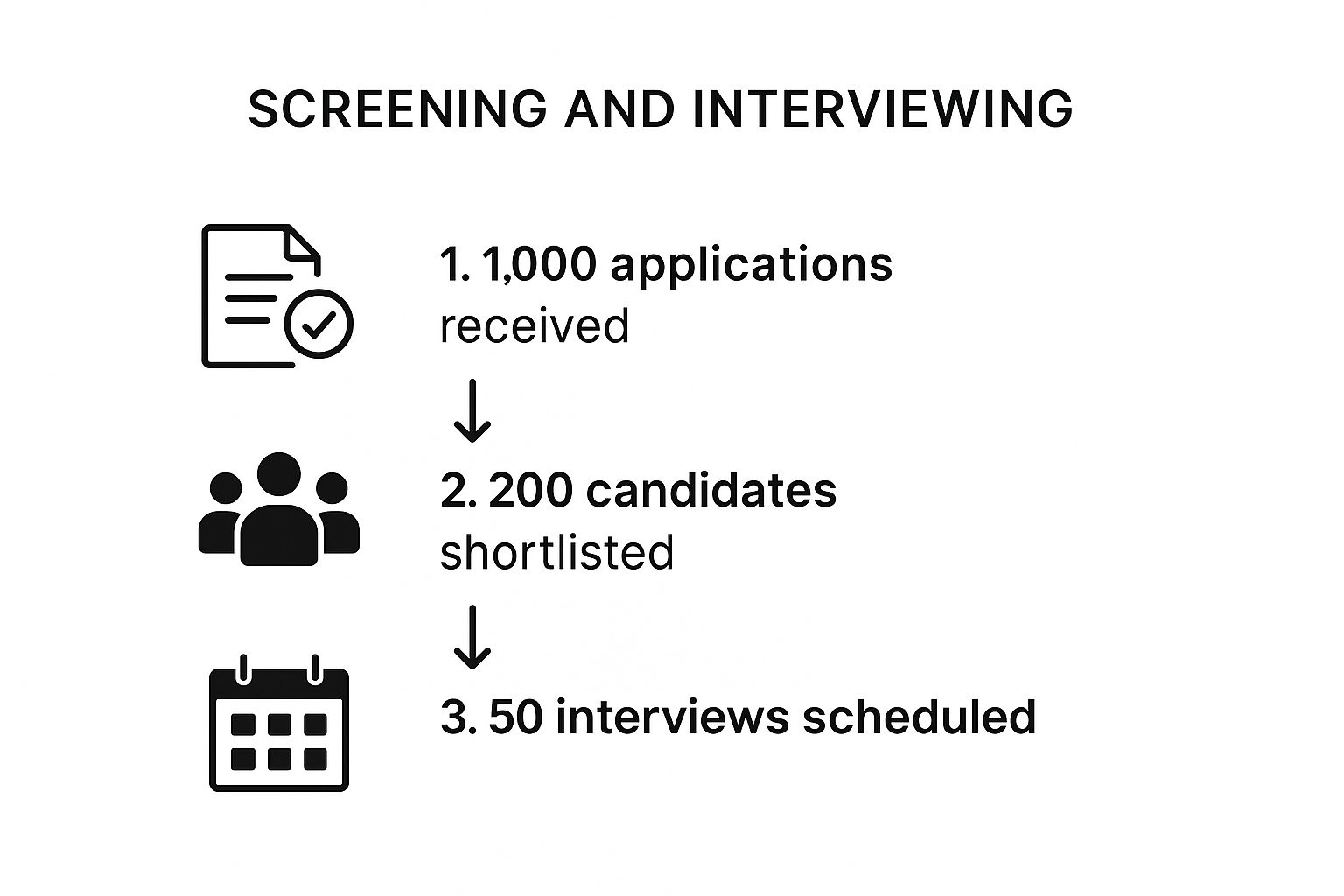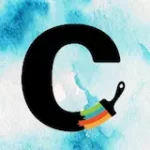Let's be honest, a chaotic hiring process costs you more than just money—it costs you top talent. Think of a recruitment process flowchart as your strategic map. It’s what transforms hiring from a series of frantic, disjointed tasks into a smooth, predictable system.
This visual guide is all about creating consistency, slashing your time-to-hire, and dramatically improving the experience for every single candidate.
Why Your Hiring Process Needs a Flowchart
An unstructured hiring process feels like navigating without a map. Recruiters might have one set of expectations while hiring managers have another. This mismatch leads to confusion, frustrating delays, and a terrible experience for candidates who inevitably get lost in the shuffle.
A recruitment process flowchart fixes this by creating a single source of truth that everyone on the team can actually see and follow. This isn't just about drawing pretty diagrams; it's about turning recruitment into a real strategic advantage. It gets everyone on the same page, ensures fairness, and stops great people from slipping through the cracks.
The Problem of Volume and Speed
Modern recruiting is a numbers game that demands efficiency. Just consider this: on a global average, around 74 applicants throw their hat in the ring for each open role. But only a tiny fraction of them—just 1.5%—end up receiving an offer.
That sheer volume makes a structured screening process non-negotiable. Without a clear flowchart, your team can easily get swamped, which leads to mistakes and missed opportunities. You can find more of these eye-opening stats in the 2025 Global Recruitment Report from Staffinghub.com.
On top of that, the average time to hire in the U.S. hovers around 35 days. A well-designed flowchart directly attacks this metric by shining a light on bottlenecks and helping you eliminate them. Suddenly, a lengthy ordeal becomes a competitive edge.
To put these numbers into perspective, here's what the funnel typically looks like.
Typical Recruitment Funnel Conversion Rates
This table breaks down the average conversion rates at each major stage of the recruitment process, illustrating the high volume of candidates at the top of the funnel and the small percentage that receives an offer.
| Hiring Stage | Global Average Conversion Rate |
|---|---|
| Application to Screening | 21% |
| Screening to Interview | 35% |
| Interview to Final Interview | 29% |
| Final Interview to Offer | 31% |
| Offer to Hire | 85% |
Seeing it laid out like this really highlights where the biggest drop-offs happen and why every step needs to be as efficient as possible.
Creating Clarity and Consistency
A flowchart gives you a clear, visual overview of every single phase, from the moment a job requisition is approved to the new hire’s first day. It immediately answers critical questions for everyone involved:
- What happens right after an application is submitted?
- Who is responsible for the initial phone screen?
- What are the exact steps in our interview stage?
- When, and how, do we communicate updates to candidates?
Even a simple diagram using basic shapes can represent actions, decisions, and outcomes, bringing instant clarity to the entire workflow.

When you standardize the process, you guarantee every candidate gets a fair and consistent evaluation—which is absolutely fundamental to building a strong employer brand. Understanding these benefits is the first step, but learning how to master your efficient hiring process can completely reshape your entire recruitment strategy.
A flowchart’s greatest strength is turning abstract processes into concrete, actionable steps. It forces those crucial conversations about ownership, timelines, and decision criteria that get completely overlooked in informal hiring setups.
This visual map is more than just a document; it's a commitment to a better way of hiring. It sets the stage for implementing more advanced approaches, which we dive into in our guide to creative recruitment strategies. By defining each step, you're building the foundation for a faster, fairer, and far more effective hiring machine.
Alright, let's get into what it really takes to map out a hiring process that doesn't just look good on paper, but actually works in the real world.
Before You Draw a Single Box: The Prep Work

Before you even think about opening a flowchart tool, you need to do some groundwork. A truly effective recruitment process flowchart isn’t built with shapes and arrows; it’s built on a solid foundation of clear goals and input from the right people. I’ve seen it happen time and time again: teams rush this part and end up with a pretty diagram that solves zero actual problems.
First things first, you need to define your scope. Are you mapping out a single, universal hiring process for the whole company? Or are you getting specific for a high-volume team like sales or a highly specialized one like engineering?
A company-wide flowchart is a great starting point for consistency. But let's be real, specialized roles often need their own unique steps. For example, our guide on how to hire designers talks all about the non-negotiable portfolio review stage—a step that makes zero sense for an accounting role. Get specific from the jump.
Get the Right People in the Room
This is probably the most common mistake I see people make: designing a process in a silo. If you want people to actually use the flowchart you create, you need their buy-in from day one. That means getting the right folks involved early and often.
You absolutely need to pull together a core group that includes:
- Hiring Managers: They’re in the trenches. They know the practical headaches and exactly what their teams need to succeed.
- Recruiters: They own this process day-to-day. They can speak to everything from candidate communication and sourcing channels to the limitations of your applicant tracking system.
- Top-Performing Employees: Seriously, grab someone who just went through your hiring gauntlet. Their perspective on the candidate experience is pure gold.
When you bring these different viewpoints together, your flowchart starts to reflect reality, not just some idealized HR theory. This is how you avoid that classic situation where a new process gets rolled out, only to be completely ignored by the very teams it was meant to help.
Take an Honest Look at Your Current Process
Now it's time for some real talk. Map out every single step of your current hiring process—and I mean everything, including all those "unofficial" workarounds that you know are happening. Sit down with your stakeholders and ask them to walk you through what really happens.
Dig in with some pointed questions:
- Where are we losing candidates? At what specific stage do they drop out most often?
- Which step is the biggest time-suck, and why?
- What have new hires told us—good or bad—about their experience?
This audit will shine a massive spotlight on your biggest bottlenecks and pain points. You might find out that simple interview scheduling is adding a full week to your time-to-hire, all because of endless email tag.
By auditing first, you move from guessing to knowing. The data you collect becomes the business case for every change you propose in your new flowchart, making it far easier to get company-wide adoption.
Finally, set some real, measurable goals. Vague ambitions like "improve hiring" won't cut it. You need concrete targets. Think: "reduce average time-to-hire by 15%" or "boost our offer acceptance rate from 80% to 90%." These goals will be your North Star, guiding every decision you make as you design the new process and giving you a clear way to measure success later on.
Mapping Your Core Recruitment Stages
Alright, the prep work is handled. Now for the fun part: bringing your recruitment process flowchart to life. This is where you visually connect every critical phase of the journey, from the moment a manager says "I need someone" all the way through to a new hire's first day. Every stage needs a clear purpose, an owner, and a defined outcome.
Think of it as building a custom roadmap. Let's be real—the path to hiring a senior developer looks nothing like the one for a customer support specialist. If your flowchart doesn't capture those differences, it's not going to be much help.
This infographic gives you a simplified look at the screening funnel. It's a stark reminder of how a massive pool of applicants gets whittled down before you even start scheduling interviews.

What this visual screams is that solid, efficient screening isn't just nice to have. It's essential if you want to manage high application volumes and not waste time on the wrong people.
From Requisition to Screening
It all kicks off with a need. The very first shape on your flowchart should be Job Requisition Approved. This isn't just a box to check; it’s the official starting gun for the race. From there, the process flows directly into Sourcing & Application, which is when you post the role and the candidates start rolling in.
The next step, Application Screening, is a major fork in the road. This is where you need clear criteria to separate the promising candidates from everyone else. For a customer support role, you might be scanning for keywords like "Zendesk" or "customer service." For that senior developer, the criteria will be way more technical—think "Python," "AWS," or "microservices architecture."
A classic mistake I see all the time is creating a generic, one-size-fits-all screening process. Your flowchart needs to get specific. A simple resume review might be fine for some roles, but a technical position might demand an automated coding challenge right at this early stage.
The Interview Gauntlet
This is where your flowchart can start to look like a tangled mess if you're not careful. Clarity is everything. Instead of one big box just labeled "Interview," you have to break it down.
Here’s what that could look like:
- Initial Phone Screen: A quick 30-minute call with a recruiter. You’re just checking for basic qualifications and getting a feel for culture fit.
- Hiring Manager Interview: Now we’re getting serious. This is a deeper dive into their experience and how they’d mesh with the team.
- Technical Assessment: This will vary wildly. For the developer, it’s a multi-hour live coding session. For the support specialist, it might be a practical test where they respond to mock customer tickets.
- Panel Interview: The final boss. This is where you bring in key team members and stakeholders for the last round of questions.
Remember, each of these steps is a decision point. After that technical assessment, your flowchart should have a diamond shape asking, "Advance to Final Round?" with clear "Yes" and "No" pathways. And that "No" path has to trigger an action, like "Send Personalized Rejection Note." This simple step ensures no candidate gets left in the dark.
Offer, Checks, and Onboarding
Once you’ve found your finalist, the flowchart moves into its closing act. The Verbal Offer Extended step kicks off the final leg of the journey. This is almost always followed by Reference & Background Checks—a crucial verification stage you don't want to skip.
Market dynamics can really shake up this part of the process. For example, the tech sector sometimes sees up to 110 applicants per role, which means you need tough, multi-layered checks. On the flip side, manufacturing enjoys the highest offer acceptance rate at 92%, suggesting their offer management can be a bit more direct. As you build this out, think about how your own industry’s quirks should shape these final steps.
But you're not done when the offer is accepted. The last stage—and you could argue it's one of the most important—is Onboarding. Don’t let your flowchart just end at "Offer Accepted." Extend it to include the first few critical steps of bringing someone new into the fold, especially if you need an effective onboarding process for remote employees. This closes the loop and makes sure your new hire feels like part of the team from day one.
A recruitment flowchart on its own is just a pretty picture. To turn it into a high-performance engine that actually helps you hire better people, faster, you need to bring it to life with the right tools and a modern mindset.
It's all about making your visual map an active, breathing part of your day-to-day workflow.
The goal here isn’t to replace human interaction. Far from it. The real magic happens when you use technology to automate the soul-crushing, repetitive tasks that bog recruiters down. This frees up your team to do what they do best: build genuine connections with promising candidates.
Treating Candidates Like Customers
A modern hiring process treats candidates like valued customers, not just another application in the pile. This is where a candidate relationship management (CRM) mindset comes into play. Your flowchart should have explicit touchpoints for communication, making sure no one ever feels like their resume vanished into a black hole.
In today’s market, you can’t afford to be careless. To get an edge, 40% of talent acquisition leaders are now focused on building stronger relationships with candidates to stop them from dropping out. This means your flowchart needs dedicated steps for status updates, asking for feedback, and nurturing communication—especially for those fantastic "silver medalist" candidates you might want to hire down the road.
As flexible work becomes the norm, you might even need separate paths in your flowchart for part-time or fractional hires. It's all about building a more adaptable hiring model.
Your Tech Stack: The Command Center
The right tech stack is the central nervous system for your flowchart, turning those visual steps into real, automated actions. One of the most important pieces of the puzzle is a good Applicant Tracking System (ATS). For an in-depth look, check out this ultimate guide to a candidate tracking system to see how it can streamline everything from application to offer.

Think of your ATS, whether it’s Greenhouse or Lever, as your command center. It’s where your flowchart lives and breathes. When you drag a candidate from one stage to the next in your ATS, it should automatically trigger the next step in your process.
To give you an idea of how this looks in practice, here are a few tools that plug into specific stages of the recruitment flowchart.
Recommended Tools for Recruitment Flowchart Stages
A great recruitment process isn't just about the steps; it's about the tools that power them. The right software can automate tedious tasks, provide deeper insights, and create a smoother experience for everyone involved. Here’s a breakdown of tool types we recommend for each stage of your hiring journey.
| Recruitment Stage | Recommended Tool Type | Example Tools |
|---|---|---|
| Sourcing & Attraction | Candidate Sourcing Platforms | LinkedIn Recruiter, Hired |
| Application & Screening | Applicant Tracking System (ATS) | Greenhouse, Lever, Workable |
| Initial Interviews | Video Interviewing Software | Spark Hire, HireVue |
| Scheduling | Automated Scheduling Tools | Calendly, GoodTime |
| Assessments | Skills Testing Platforms | HackerRank (for tech), TestGorilla |
| Final Interviews | Video Conferencing Tools | Zoom, Google Meet |
| Offer & Onboarding | HRIS & Onboarding Software | BambooHR, Rippling |
Integrating these tools doesn't just add efficiency; it creates a connected ecosystem where data flows seamlessly from one step to the next, giving your team the power to make smarter, faster hiring decisions.
Your flowchart shouldn't just show what happens, but what tool makes it happen. For instance, your "Initial Screen" box should be directly linked to your video interview platform or the screening module in your ATS.
This tech-integrated approach is something we see in other parts of the business all the time. Many teams use creative project management software to map out workflows and assign specific tools to tasks. The exact same logic applies perfectly to recruitment.
Building in Fairness and Inclusion
Finally, a truly modern flowchart must have built-in checkpoints for diversity and inclusion (D&I). And believe it or not, technology can be a powerful ally here.
You can use your flowchart to mandate specific actions that promote fairness. For example, add a "D&I Checkpoint" step right before the final interview stage. This could be a formal review of the shortlist to ensure it reflects a diverse pool of qualified candidates.
Tools that redact names and other identifying details from initial applications can also be a formal step in your flowchart. By embedding these practices directly into your visual process, you make fairness a non-negotiable part of how you hire. It's not an afterthought; it's just how things are done.
Bringing Your Flowchart to Life
So you've built the perfect recruitment process flowchart. It’s clean, logical, and makes perfect sense on paper. That's a huge step, but let's be real—a diagram tucked away in a shared drive has never hired anyone.
The real magic happens when you bring that flowchart to life. This is the part where your visual map goes from being a plan to becoming an active, breathing part of how your company actually hires.
First things first: you have to get your team on board. Simply emailing the new flowchart to your hiring managers and hoping for the best is a recipe for failure. Instead, get everyone in a room (or a Zoom) for a proper kickoff meeting.
Your job is to walk them through the entire process, but don't just explain what is changing. You need to sell them on the why. For instance, if you’ve added a mandatory scorecard for interviews, explain how this isn't just more admin work—it's a proven way to reduce unconscious bias and make smarter, data-backed hiring decisions.
Measuring What Truly Matters
You can't improve what you don't measure. A key part of making your flowchart work is tracking the right metrics to see if it’s actually making a difference. Your new process should have a direct, positive impact on the numbers that matter.
Here are the essentials you should start tracking immediately:
- Time-to-Fill: How long does it take to get from an approved job req to a signed offer? A well-oiled process, guided by your flowchart, should shrink this timeline.
- Offer Acceptance Rate: Are your top candidates actually saying "yes"? A better candidate experience, which should be baked into your flowchart, almost always boosts this number.
- Quality-of-Hire: This one’s trickier but absolutely vital. You can get a good read on this with post-hire surveys and performance check-ins around the 90-day mark. Are your new hires meeting or exceeding expectations?
- Source Effectiveness: Where are your best people coming from? Your flowchart should help you pinpoint which channels are delivering high-quality candidates, not just a high volume of them.
This data is your proof. It shows everyone that the new process isn't just busywork—it’s a strategic move that delivers real results. For more specialized roles, you might even get more granular. If you're figuring out how to hire a graphic designer, for example, you could track the quality of portfolios you receive at each stage of the funnel.
Your Flowchart Is a Living Document
Probably the biggest mistake I see companies make is treating their flowchart like a finished project. It's not. Your business will grow, the job market will shift, and you'll uncover bottlenecks you never expected. Your flowchart has to evolve right along with you.
A flowchart should never be set in stone. Treat it like software, with regular updates and version control. It's a tool for continuous improvement, not a static rulebook.
To make this a reality, put a recurring meeting on the calendar to review your hiring process—at least every six months. Get those same stakeholders back together: hiring managers, recruiters, and even some recent hires who just went through the process. Ask them point-blank: what's working, and what's causing friction?
Use the data you've been collecting to drive the conversation. If your time-to-fill for engineers is still lagging, zoom in on that part of the flowchart. Maybe the technical assessment is too long, or perhaps scheduling panel interviews is still a nightmare.
By combining that hard data with real human feedback, you can make smart, targeted adjustments. This iterative approach is what ensures your recruitment process doesn't just start strong—it actually gets better and better over time.
Got Questions? We've Got Answers
You've mapped out your process, but a few questions might still be bubbling up. That's totally normal. Let's tackle some of the most common ones that pop up when teams start using a recruitment flowchart for the first time.
How Often Should I Actually Update This Thing?
Look, your flowchart isn't a museum piece. You can't just create it, frame it, and forget it. The best habit to get into is reviewing it at least once a year. You'll also want to pull it out anytime your company makes a big move—maybe you're growing like crazy, launching a new department, or shifting your strategy to embrace more remote roles.
A more urgent trigger? Your hiring metrics. If your time-to-fill is creeping up or your offer acceptance rate suddenly tanks, something's broken. That’s your cue to pull up the flowchart and find the weak link. Think of it as a living, breathing guide that grows with your business.
What's the Biggest Mistake People Make When Designing a Flowchart?
Hands down, the biggest mistake is making it way too complicated. A recruitment process flowchart is supposed to create clarity, not a bureaucratic maze that makes everyone want to pull their hair out. If you pile on a dozen unnecessary approval steps, you're just slowing things down and frustrating your team.
Another classic blunder? Designing it in a vacuum. When the HR team builds the flowchart without talking to the actual hiring managers, it's a recipe for disaster. You end up with a process that sounds good in theory but completely ignores how hiring actually works on the ground.
Always keep it simple, clear, and collaborative. A flowchart that’s built with the hiring team is a flowchart that will actually get used.
Can I Just Use One Flowchart For Every Single Role?
You can definitely start with a core template, but trying to use one-size-fits-all for every role is a mistake. The process for hiring an entry-level assistant should feel a lot lighter and faster than the one for a C-suite executive. It just makes sense.
For example, hiring a developer is probably going to involve a technical coding test. For a creative role, you’ll absolutely need a step for a portfolio review. If you're hiring for highly specialized positions, you might need to get even more specific—you can see how different the approach is by looking at tailored interview questions for creatives.
The smartest approach is to build a master flowchart with the standard stages, then create a few variations with specific steps for different departments or seniority levels.
At Creativize, we’re all about connecting great companies with top-tier local creative talent. If you’re looking for the right designers, animators, or branding experts for your next big thing, we can help. Discover creative professionals on Creativize.

